Fabrication of Self-Assembling Carbon Nanotube Forest Fishnet Metamaterials
Abstract
:1. Introduction
2. Materials and Methods
3. Results
4. Conclusions
Author Contributions
Funding
Institutional Review Board Statement
Informed Consent Statement
Data Availability Statement
Acknowledgments
Conflicts of Interest
Appendix A
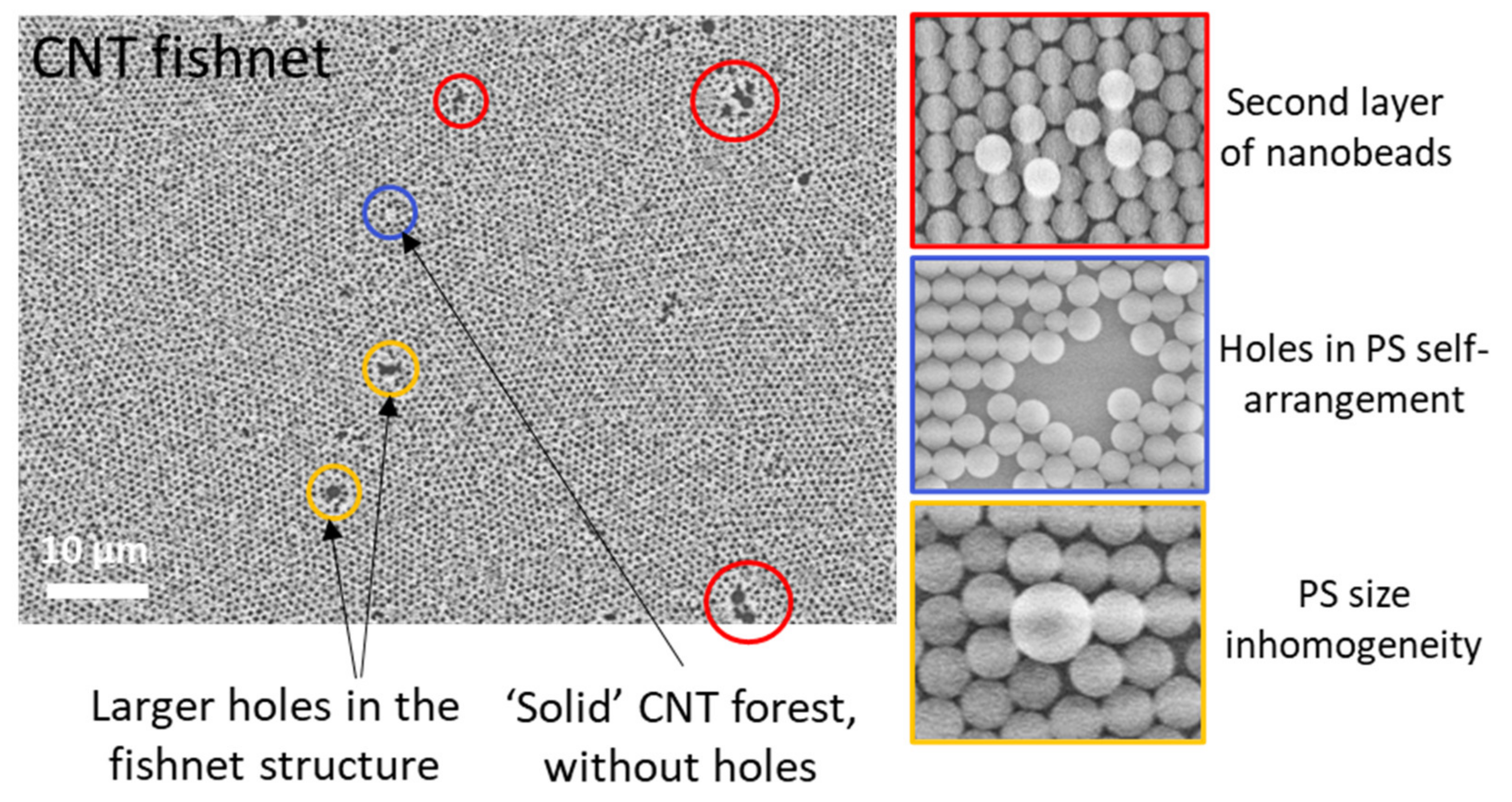
Appendix B
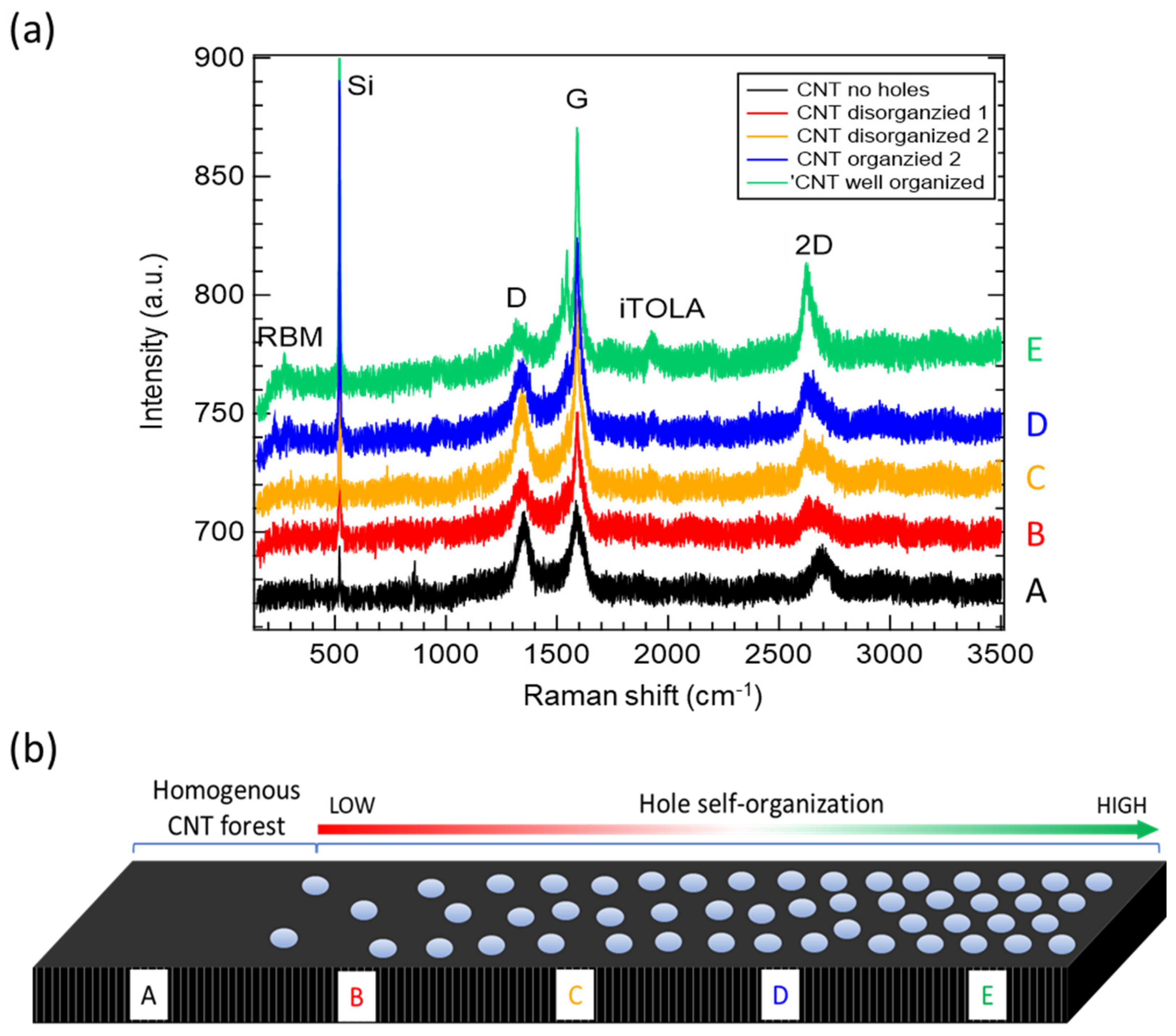
References
- Pendry, S.J. Metamaterials and the control of electromagnetic fields. In Conference on Coherence and Quantum Optics; Optical Society of America: Washington, DC, USA, 2007. [Google Scholar]
- Sparavigna, A.C. Vibrations of a one-dimensional host-guest system. Mater. Sci. Appl. 2011, 2, 314–318. [Google Scholar] [CrossRef] [Green Version]
- Shalaev, V.M. Optical negative-index metamaterials. Nat. Photonics 2007, 1, 41–48. [Google Scholar] [CrossRef]
- Linden, S.; Enkrich, C.; Wegener, M.; Zhou, J.; Koschny, T.; Soukoulis, C.M. Magnetic response of metamaterials at 100 terahertz. Science 2004, 306, 1351–1353. [Google Scholar] [CrossRef] [Green Version]
- Fang, A.; Huang, Z.; Koschny, T.; Soukoulis, C.M. Overcoming the losses of a split ring resonator array with gain. Opt. Express 2011, 19, 12688–12699. [Google Scholar] [CrossRef] [PubMed]
- Roppo, V.; Centini, M.; de Ceglia, D.; Vicenti, M.A.; Haus, J.W.; Akozbek, N.; Bloemer, M.J.; Scalora, M. Anomalous momentum states, non-specular reflections, and negative refraction of phase-locked, second-harmonic pulses. Metamaterials 2008, 2, 135–144. [Google Scholar] [CrossRef]
- Suchowski, H.; O’Brien, K.; Wong, Z.J.; Salandrino, A.; Yin, X.; Zhang, X. Phase mismatch-free nonlinear propagation in optical zero-index materials. Science 2013, 342, 1223–1226. [Google Scholar] [CrossRef] [PubMed] [Green Version]
- Furuta, H.; Kawaharamura, T.; Furuta, M.; Kawabata, K.; Hirao, T.; Komukai, T.; Yoshihara, K.; Shimomoto, Y.; Oguchi, T. Crystal structure analysis of multiwalled carbon nanotube forests by newly developed cross-sectional X-ray diffraction measurement. Appl. Phys. Express 2010, 3, 105101. [Google Scholar] [CrossRef]
- Furuta, H.; Kawaharamura, T.; Kawabata, K.; Furuta, M.; Matsuda, T.; Li, C.; Hirao, T. High-density short-height directly grown CNT patterned emitter on glass. e-J. Surf. Sci. Nanotechnol. 2010, 8, 336–339. [Google Scholar] [CrossRef] [Green Version]
- Dai, H. Carbon nanotubes: Opportunities and challenges. Surf. Sci. 2002, 500, 218–241. [Google Scholar] [CrossRef]
- De Heer, W.A.; Chatelain, A.; Ugarte, D. A carbon nanotube field-emission electron source. Science 1995, 270, 1179–1180. [Google Scholar] [CrossRef]
- Nikolaenko, A.E.; De Angelis, F.; Boden, S.A.; Papasimakis, N.; Ashburn, P.; Di Fabrizio, E.; Zheludev, N.I. Carbon Nanotubes in a Photonic Metamaterial. Phys. Rev. Lett. 2010, 104, 153902. [Google Scholar] [CrossRef] [PubMed] [Green Version]
- Yang, D.J.; Wang, S.G.; Zhang, Q.; Sellin, P.J.; Chen, G. Thermal and electrical transport in multi-walled carbon nanotubes. Phys. Lett. A 2004, 329, 207–213. [Google Scholar] [CrossRef]
- Murakami, Y.; Einarsson, E.; Edamura, T.; Maruyama, S. Polarization dependent optical absorption properties of single-walled carbon nanotubes and methodology for the evaluation of their morphology. Carbon 2005, 43, 2664–2676. [Google Scholar] [CrossRef]
- Ichida, M.; Mizuno, S.; Kataura, H.; Achiba, Y.; Nakamura, A. Anisotropic optical properties of mechanically aligned single-walled carbon nanotubes in polymer. Appl. Phys. A 2004, 78, 1117–1120. [Google Scholar] [CrossRef]
- Avouris, P.; Chen, J.; Freitag, M.; Perebeinos, V.; Tsang, J.C. Carbon nanotube optoelectronics. Phys. Status Solidi 2006, 243, 3197–3203. [Google Scholar] [CrossRef]
- Nicholson, J.W.; Windeler, R.S.; Digiovanni, D.J. Optically driven deposition of single-walled carbon-nanotube saturable absorbers on optical fiber end-faces. Opt. Express 2007, 15, 9176–9183. [Google Scholar] [CrossRef]
- Bahena-Garrido, S.; Shimoi, N.; Abe, D.; Hojo, T.; Tanaka, Y.; Tohji, K. Plannar light source using a phosphor screen with single-walled carbon nanotubes as field emitters. Rev. Sci. Instrum. 2014, 85, 104704. [Google Scholar] [CrossRef]
- Zhang, T.-F.; Li, Z.-P.; Wang, J.-Z.; Kong, W.-Y.; Wu, G.-A.; Zheng, Y.-Z.; Zhao, Y.-W.; Yao, E.-X.; Zhuang, N.-X.; Luo, L.-B. Broadband photodetector based on carbon nanotube thin film/single layer graphene Schottky junction. Sci. Rep. 2016, 6, 38569. [Google Scholar] [CrossRef] [Green Version]
- Butt, H.; Dai, Q.; Farah, P.; Butler, T.; Wilkinson, T.D.; Baumberg, J.J.; Amaratunga, G.A.J. Metamaterial high pass filter based on periodic wire arrays of multiwalled carbon nanotubes. Appl. Phys. Lett. 2010, 97, 163102. [Google Scholar] [CrossRef]
- Butt, H.; Dai, Q.; Rajesekharan, R.; Wilkinson, T.D.; Amaratunga, G.A.J. Plasmonic band gaps and waveguide effects in carbon nanotube arrays based metamaterials. ACS Nano 2011, 5, 9138–9143. [Google Scholar] [CrossRef]
- Butt, H.; Yetisen, A.K.; Ahmed, R.; Yun, S.H.; Dai, Q. Carbon nanotube biconvex microcavities. Appl. Phys. Lett. 2015, 106, 121108. [Google Scholar] [CrossRef]
- Hong, J.T.; Park, D.J.; Yim, J.H.; Park, J.K.; Park, J.-Y.; Lee, S.; Ahn, Y.H. Dielectric constant engineering of single-walled carbon nanotube films for metamaterials and plasmonic devices. J. Phys. Chem. Lett. 2013, 4, 3950–3957. [Google Scholar] [CrossRef]
- Wu, H.; Zhong, Y.; Tang, Y.; Huang, Y.; Liu, G.; Sun, W.; Xie, P.; Pan, D.; Liu, C.; Guo, Z. Precise regulation of weakly negative permittivity in CaCu3Ti4O12 metacomposites by synergistic effects of carbon nanotubes and grapheme. Adv. Compos. Hybrid. Mater. 2021, 4, 1–12. [Google Scholar] [CrossRef]
- Qi, G.; Liu, Y.; Chen, L.; Xie, P.; Pan, D.; Shi, Z.; Quan, B.; Zhong, Y.; Liu, C.; Fan, R.; et al. Lightweight Fe3C@Fe/C nanocomposites derived from wasted cornstalks with high-efficiency microwave absorption and ultrathin thickness. Adv. Compos. Hybrid. Mater. 2021, 4, 1226–1238. [Google Scholar] [CrossRef]
- Pander, A.; Takano, K.; Hatta, A.; Nakajima, M.; Furuta, H. Shape-dependent infrared reflectance properties of CNT forest metamaterial arrays. Opt. Express 2020, 28, 607–625. [Google Scholar] [CrossRef] [PubMed]
- Pander, A.; Takano, K.; Hatta, A.; Nakajima, M.; Furuta, H. The influence of the inner structure of CNT forest metamaterials in the infrared regime. Diam. Relat. Mater. 2017, 80, 99–107. [Google Scholar] [CrossRef]
- Ponsinet, V.; Baron, A.; Pouget, E.; Okazaki, Y.; Oda, R.; Barois, P. Self-assembled nanostructured metamaterials(a). Europhys. Lett. 2017, 119, 14004. [Google Scholar] [CrossRef] [Green Version]
- Pawlak, D.A.; Turczynski, S.; Gajc, M.; Kolodziejak, K.; Diduszko, R.; Rozniatowski, K.; Smalc, J.; Vendik, I. How far are we from making metamaterials by self-organization? the microstructure of highly anisotropic particles with an SRR-like geometry. Adv. Funct. Mater. 2010, 20, 1116–1124. [Google Scholar] [CrossRef]
- Volgin, V.M.; Lyubimov, V.V.; Gnidina, I.V.; Kabanova, T.B.; Davydov, A.D. Modeling of Electrochemical Machining Through a Monolayer Colloidal Crystal Mask for Metal Surfaces Nanostructuring. Procedia CIRP 2016, 42, 350–355. [Google Scholar] [CrossRef]
- Gómez-Castaño, M.; Zheng, H.; García-Pomar, J.L.; Vallée, R.; Mihi, A.; Ravaine, S. Tunable index metamaterials made by bottom-up approaches. Nanoscale Adv. 2019, 1, 1070–1076. [Google Scholar] [CrossRef] [Green Version]
- Ho, C.C.; Chen, P.Y.; Lin, K.H.; Juan, W.T.; Lee, W.L. Fabrication of monolayer of polymer/nanospheres hybrid at a water-air interface. ACS Appl. Mater. Interfaces 2011, 3, 204–208. [Google Scholar] [CrossRef] [PubMed]
- Wang, Y.; Zhang, M.; Lai, Y.; Chi, L. Advanced colloidal lithography: From patterning to applications. Nano Today 2018, 22, 36–61. [Google Scholar] [CrossRef]
- Zhang, J.-T.; Wang, L.; Chao, X.; Velankar, S.S.; Asher, S.A. Vertical spreading of two-dimensional crystalline colloidal arrays. J. Mater. Chem. C 2013, 1, 6099–6102. [Google Scholar] [CrossRef]
- Park, Y.-S.; Yoon, S.Y.; Lee, J.S. Wetting behavior on hexagonally close-packed polystyrene bead arrays with different topographies.pdf. Soft Matter 2016, 12, 674–677. [Google Scholar] [CrossRef]
- Tan, S.; Yan, F.; Xu, N.; Zheng, J.; Wang, W.; Zhang, W. Broadband terahertz metamaterial absorber with two interlaced fishnet layers. AIP Adv. 2018, 8, 025020. [Google Scholar] [CrossRef] [Green Version]
- Shen, J.; Li, Q.; Townsend, S.; Zhou, S.; Huang, X.; Xie, Y.M. Design of fishnet metamaterials with broadband negative refractive index in the visible spectrum. Opt. Lett. 2014, 39, 2415–2418. [Google Scholar] [CrossRef]
- Torres, V.; Rodríguez-Ulibarri, P.; Navarro-Cía, M.; Beruete, M. Fishnet metamaterial from an equivalent circuit perspective. Appl. Phys. Lett. 2012, 101, 244101. [Google Scholar] [CrossRef]
- Beruete, M.; Navarro-Cía, M.; Sorolla, M.; Campillo, I. Planoconcave lens by negative refraction of stacked subwavelength hole arrays. Opt. Express 2008, 16, 9677. [Google Scholar] [CrossRef]
- Navarro-Cia, M.; Beruete, M.; Campillo, I.; Sorolla, M. Millimeter-wave left-handed extraordinary transmission metamaterial demultiplexer. IEEE Antennas Wirel. Propag. Lett. 2009, 8, 212–215. [Google Scholar] [CrossRef]
- Navarro-Cía, M.; Beruete, M.; Sorolla, M.; Campillo, I. Converging biconcave metallic lens by double-negative extraordinary transmission metamaterial. Appl. Phys. Lett. 2009, 94, 144107. [Google Scholar] [CrossRef] [Green Version]
- Wang, Y.; Maspoch, D.; Zou, S.; Schatz, G.C.; Smalley, R.E.; Mirkin, C.A. Controlling the shape, orientation, and linkage of carbon nanotube features with nano affinity templates. Proc. Natl. Acad. Sci. USA 2006, 103, 2026–2031. [Google Scholar] [CrossRef] [PubMed] [Green Version]
- Kim, Y.; Minami, N.; Zhu, W.; Kazaoui, S.; Azumi, R.; Matsumoto, M. Langmuir-Blodgett Films of Single-Wall Carbon Nanotubes: Layer-by-Layer Deposition and In-plane Orientation of Tubes. Jpn. J. Appl. Phys. 2003, 42, 7629–7634. [Google Scholar] [CrossRef] [Green Version]
- Walters, D.A.; Casavant, M.J.; Qin, X.C.; Huffman, C.B.; Boul, P.J.; Ericson, L.M.; Haroz, E.H.; O’Connell, M.J.; Smith, K.; Colbert, D.T.; et al. In-plane-aligned membranes of carbon nanotubes. Chem. Phys. Lett. 2001, 338, 14–20. [Google Scholar] [CrossRef]
- Xin, H.; Woolley, A.T. Directional orientation of carbon nanotubes on surfaces using a gas flow cell. Nano Lett. 2004, 4, 1481–1484. [Google Scholar] [CrossRef]
- Kocabas, C.; Meitl, M.A.; Gaur, A.; Shim, M.; Rogers, J.A. Aligned arrays of single-walled carbon nanotubes generated from random networks by orientationally selective laser ablation. Nano Lett. 2004, 4, 2421–2426. [Google Scholar] [CrossRef]
- Collins, P.G.; Arnold, M.S.; Avouris, P. Engineering Carbon Nanotubes and Nanotube Circuits Using Electrical Breakdown. Science 2001, 292, 706–709. [Google Scholar] [CrossRef]
- Gao, J.; Yu, A.; Itkis, M.E.; Bekyarova, E.; Zhao, B.; Niyogi, S.; Haddon, R.C. Large-scale fabrication of aligned single-walled carbon nanotube array and hierarchical single-walled carbon nanotube assembly. J. Am. Chem. Soc. 2004, 126, 16698–16699. [Google Scholar] [CrossRef]
- Meitl, M.A.; Zhou, Y.; Gaur, A.; Jeon, S.; Usrey, M.L.; Strano, M.S.; Rogers, J.A. Solution Casting and Transfer Printing Single-Walled Carbon Nanotube Films. Nano Lett. 2004, 4, 1643–1647. [Google Scholar] [CrossRef]
- Hong, S.; Lee, J.; Do, K.; Lee, M.; Kim, J.H.; Lee, S.; Kim, D.H. Stretchable Electrode Based on Laterally Combed Carbon Nanotubes for Wearable Energy Harvesting and Storage Devices. Adv. Funct. Mater. 2017, 27, 1704353. [Google Scholar] [CrossRef]
- Ghai, V.; Bedi, H.S.; Bhinder, J.; Chauhan, A.; Singh, H.; Agnihotri, P.K. Catalytic-free growth of VACNTs for energy harvesting. Fuller. Nanotub. Carbon Nanostructures 2020, 28, 907–912. [Google Scholar] [CrossRef]
- Matsuno, Y.; Sakurai, A. Electromagnetic resonances of wavelength-selective solar absorbers with film-coupled fishnet gratings. Opt. Commun. 2017, 385, 118–123. [Google Scholar] [CrossRef]
- Udorn, J.; Hatta, A.; Furuta, H. Carbon Nanotube (CNT) Honeycomb Cell Area-Dependent Optical Reflectance. Nanomaterials 2016, 6, 202. [Google Scholar] [CrossRef] [PubMed] [Green Version]
- Oseli, A.; Vesel, A.; Mozetič, M.; Žagar, E.; Huskić, M.; Slemenik Perše, L. Nano-mesh superstructure in single-walled carbon nanotube/polyethylene nanocomposites, and its impact on rheological, thermal and mechanical properties. Compos. Part A Appl. Sci. Manuf. 2020, 136, 105972. [Google Scholar] [CrossRef]
- Nemati, A.; Wang, Q.; Hong, M.; Teng, J. Tunable and reconfigurable metasurfaces and metadevices. Opto-Electron. Adv. 2018, 1, 18000901–18000925. [Google Scholar] [CrossRef] [Green Version]
- Nurazzi, N.M.; Sabaruddin, F.A.; Harussani, M.M.; Kamarudin, S.H.; Rayung, M.; Asyraf, M.R.M.; Aisyah, H.A.; Norrrahim, M.N.F.; Ilyas, R.A.; Abdullah, N.; et al. Mechanical Performance and Applications of CNTs Reinforced Polymer Composites—A Review. Nanomaterials 2021, 11, 2186. [Google Scholar] [CrossRef]
- Muralidharan, N.; Teblum, E.; Westover, A.S.; Schauben, D.; Itzhak, A.; Muallem, M.; Nessim, G.D.; Pint, C.L. Carbon Nanotube Reinforced Structural Composite Supercapacitor. Sci. Rep. 2018, 8, 17662. [Google Scholar] [CrossRef]
- Ding, P.; Liang, E.J.; Hu, W.Q.; Zhang, L.; Zhou, Q.; Xue, Q.Z. Numerical simulations of terahertz double-negative metamaterial with isotropic-like fishnet structure. Photonics Nanostruct. Fundam. Appl. 2009, 7, 92–100. [Google Scholar] [CrossRef]
- Pander, A.; Ishimoto, K.; Hatta, A.; Furuta, H. Significant decrease in the reflectance of thin CNT forest films tuned by the Taguchi method. Vacuum 2018, 154, 285–295. [Google Scholar] [CrossRef]
- Pander, A.; Hatta, A.; Furuta, H. Optimization of catalyst formation conditions for synthesis of carbon nanotubes using Taguchi method. Appl. Surf. Sci. 2016, 371, 425–435. [Google Scholar] [CrossRef]
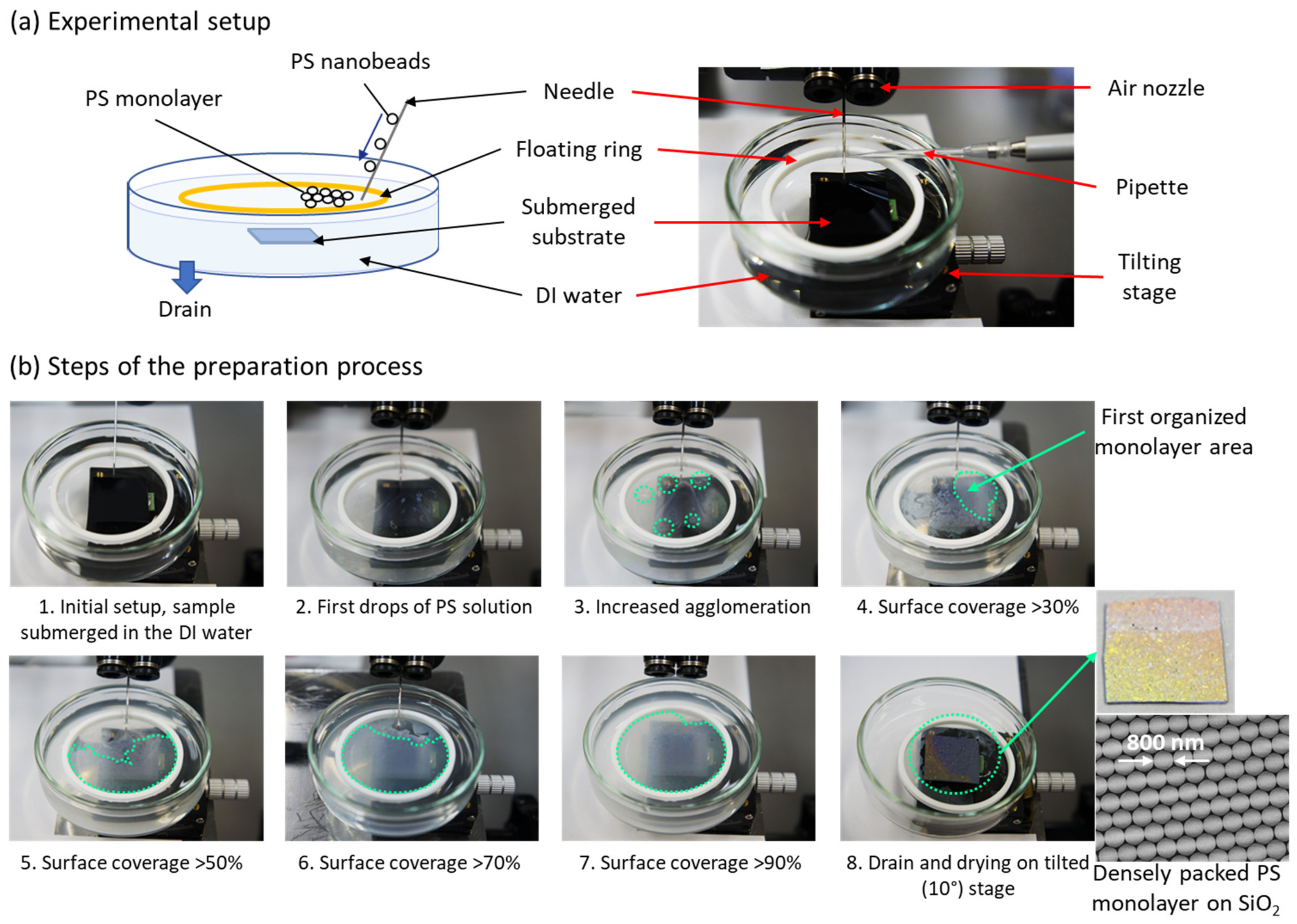
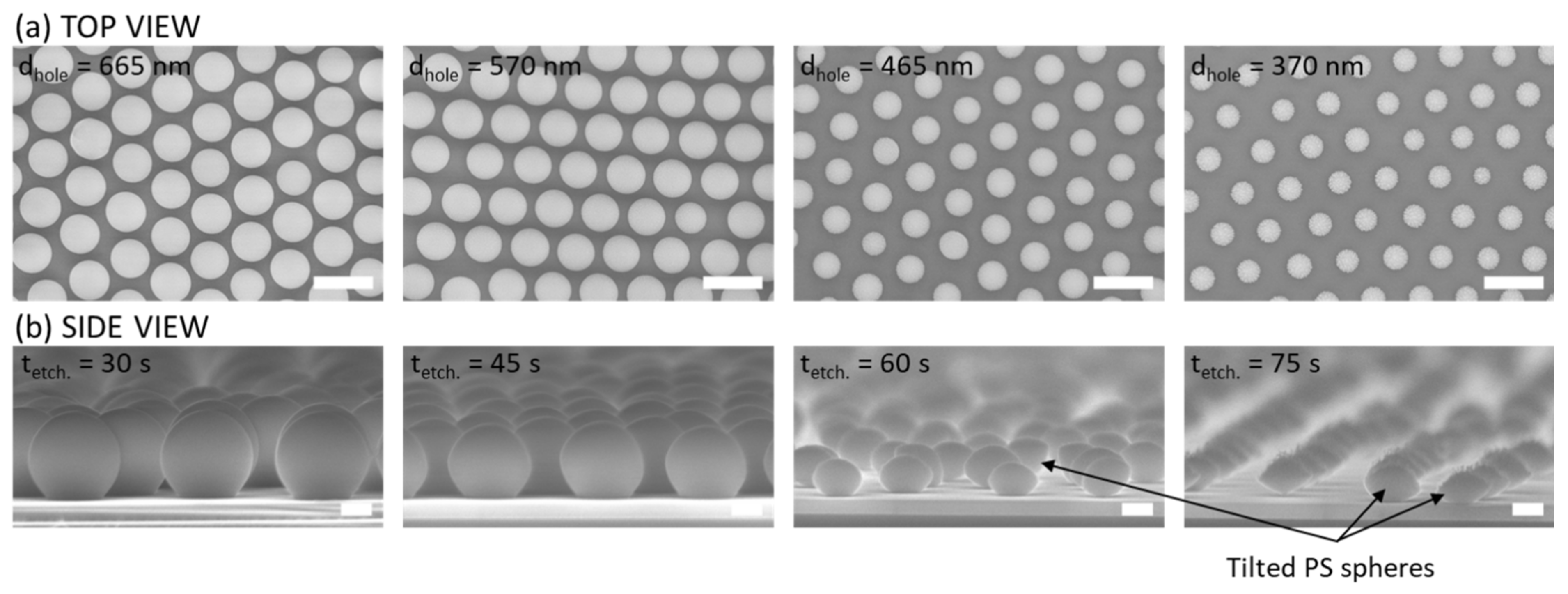
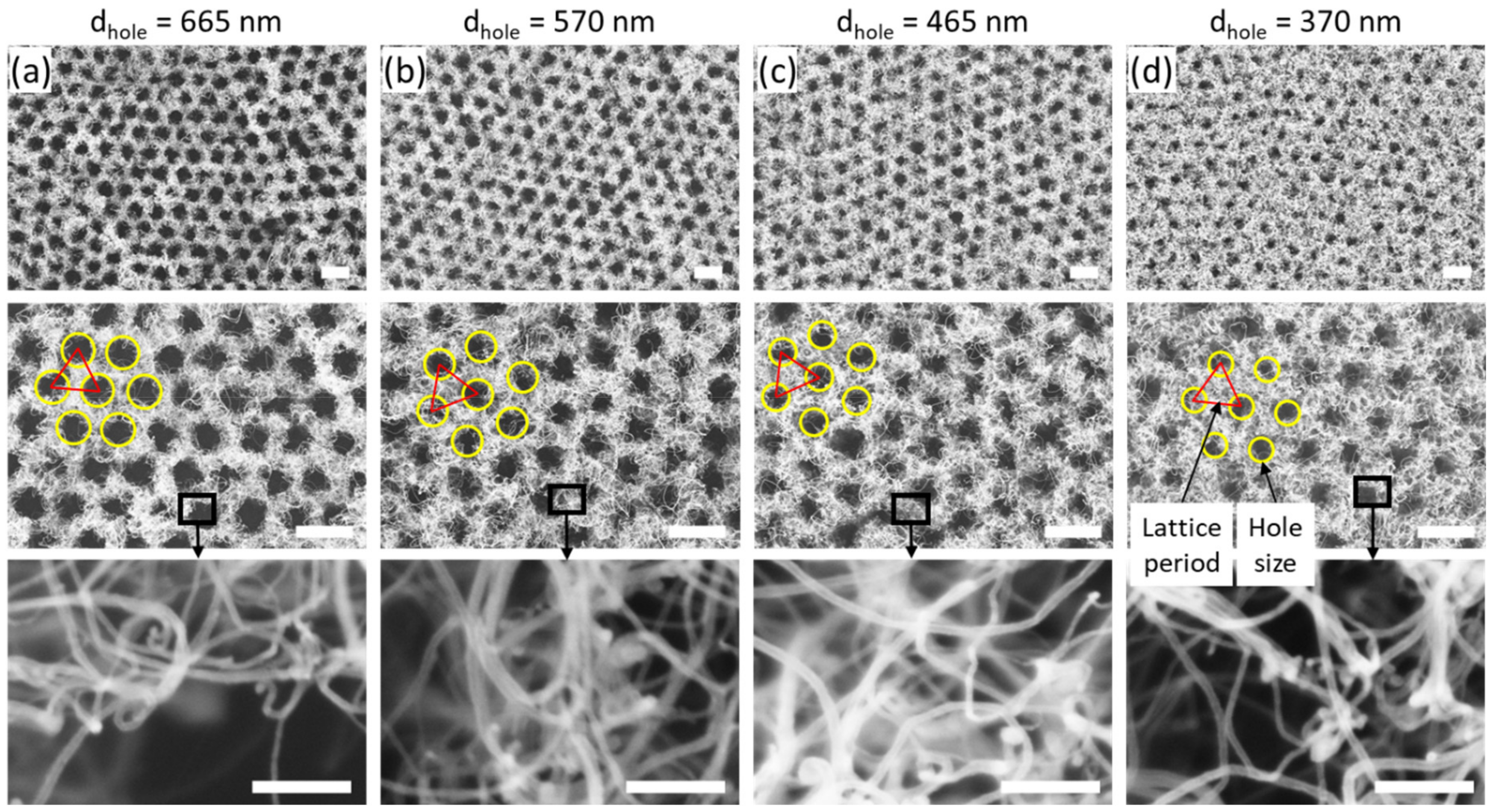
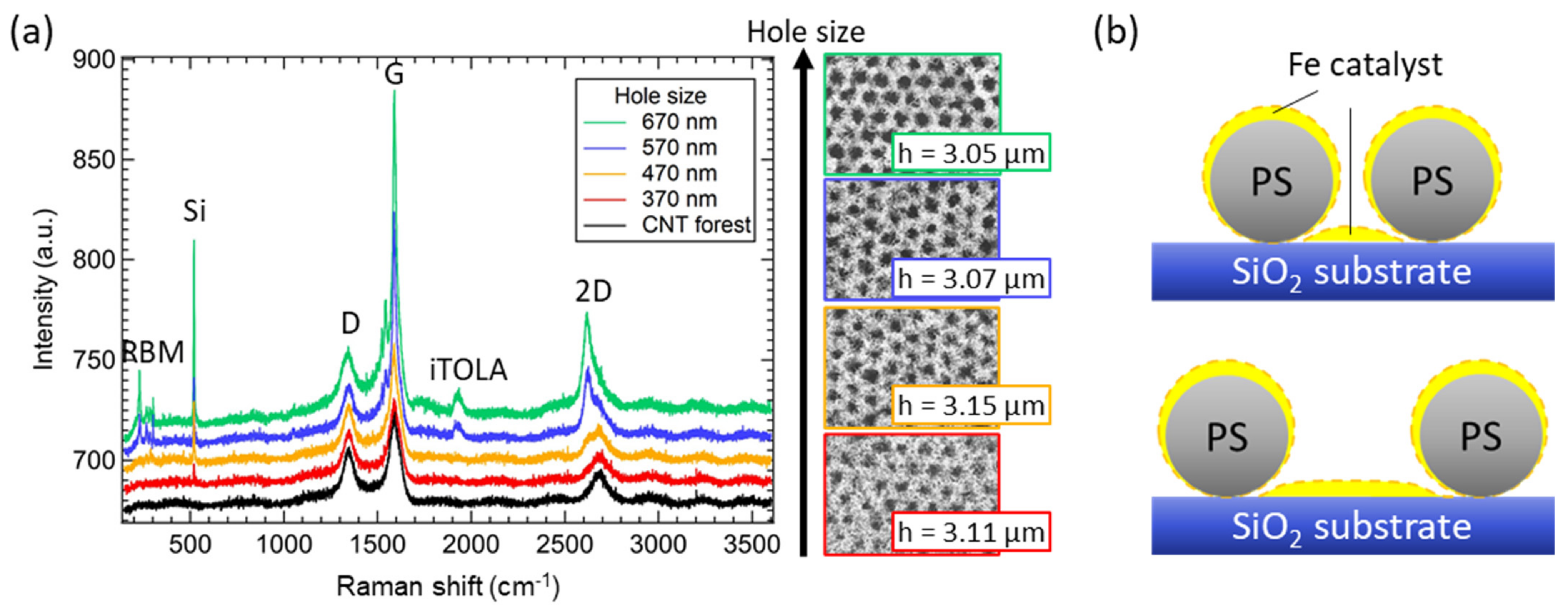
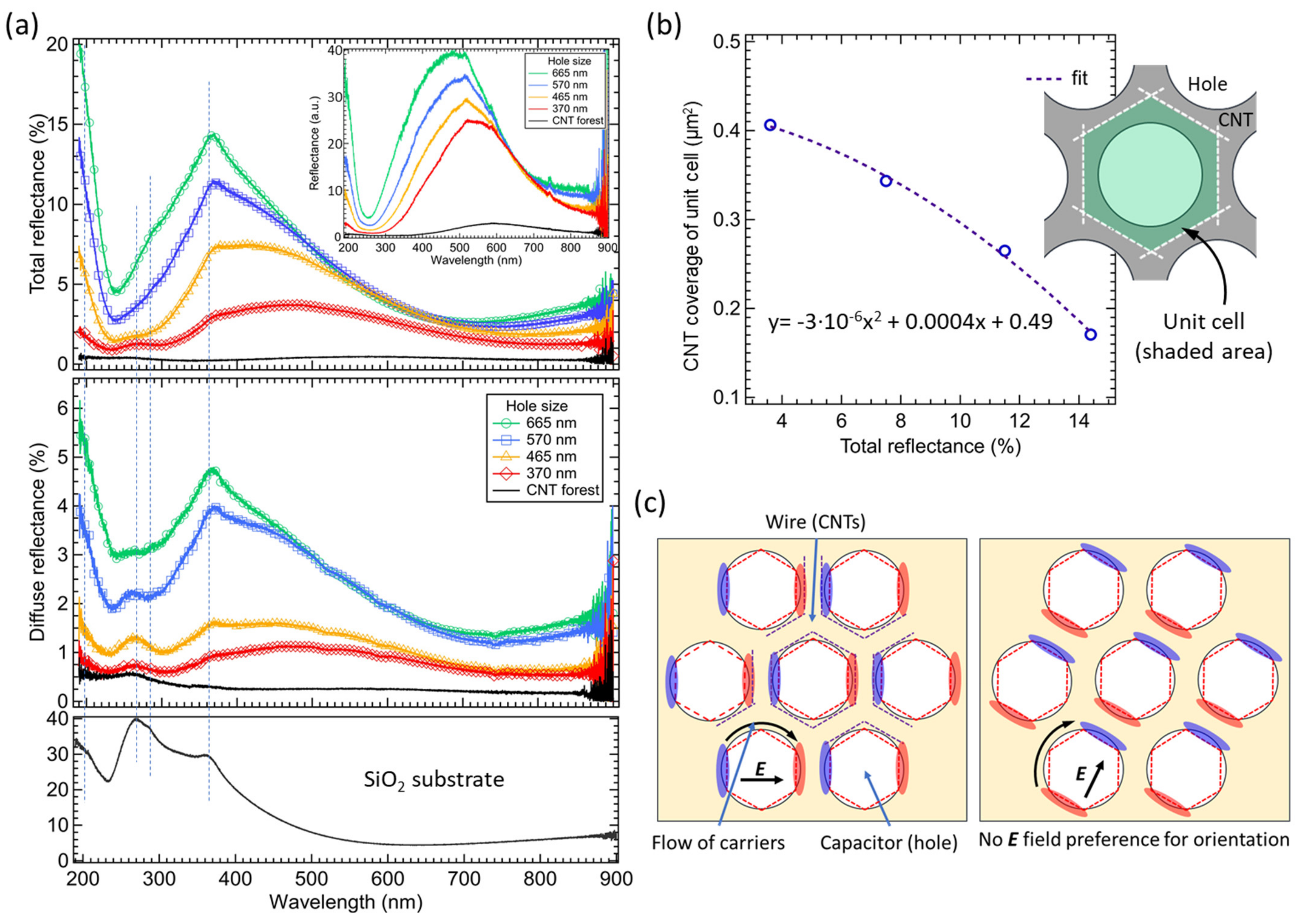
Publisher’s Note: MDPI stays neutral with regard to jurisdictional claims in published maps and institutional affiliations. |
© 2022 by the authors. Licensee MDPI, Basel, Switzerland. This article is an open access article distributed under the terms and conditions of the Creative Commons Attribution (CC BY) license (https://creativecommons.org/licenses/by/4.0/).
Share and Cite
Pander, A.; Onishi, T.; Hatta, A.; Furuta, H. Fabrication of Self-Assembling Carbon Nanotube Forest Fishnet Metamaterials. Nanomaterials 2022, 12, 464. https://doi.org/10.3390/nano12030464
Pander A, Onishi T, Hatta A, Furuta H. Fabrication of Self-Assembling Carbon Nanotube Forest Fishnet Metamaterials. Nanomaterials. 2022; 12(3):464. https://doi.org/10.3390/nano12030464
Chicago/Turabian StylePander, Adam, Takatsugu Onishi, Akimitsu Hatta, and Hiroshi Furuta. 2022. "Fabrication of Self-Assembling Carbon Nanotube Forest Fishnet Metamaterials" Nanomaterials 12, no. 3: 464. https://doi.org/10.3390/nano12030464






